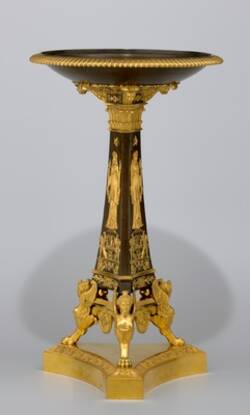Further Media
This bronze centrepiece is a so-called Athénienne. It was particularly popular in French Classicism and adorned princely tables, often in pairs. The bowl with its gilded egg and dart edge was used to store either incense or liquids.
The shape of the centrepiece is indebted to ancient tripods. As with the Meissen porcelain centrepiece, the decorative elements testify to the increased interest in the formal language of Ancient Egypt. Winged sphinxes on lion feet support a triangular, curved stele on which various ornaments are applied, including winged sphinxes as well as tendril motifs. The stele ends in a capital, which – as in classical architecture – is followed by a kind of entablature on which the bowl rests.
Unfortunately, no information is available about the original owner of the centrepiece. It was acquired for the museum in 1912 from the Dresden art market for the handsome price of 600 marks. Comparable pieces have survived in private ownership. Whether they were part of a larger commission together with our centrepiece must remain an open question. An example from the Champalimaud Collection auctioned at Christie's in July 2005 suggests a serial production. It is interesting that in this case even the original lid has survived. Its openwork vine ornaments suggest that the centrepiece functioned as an incense burner, or brûle parfum. The standing female figure with burning torches in her hands, who is depicted on all three sides of the stele in both this version and in ours, confirm this hypothesis.
The design of the Athénienne goes back to the famous French architects Charles Percier (1764-1838) and Pierre François Léonard Fontaine (1762-1853). In their Recueil de Décorations Intérieures, published between 1801-1812, they depicted, among many other objects, an elaborately designed table “executed in Saint Petersburg” for a “Count S.”, which is comparable to the present centrepiece down to the smallest details. The French sculptor Pierre-Philippe Thomire (1751-1843) can be considered for the execution after the popular models of Percier and Fontaine. As the first bronzier of his time, he created some of the most accomplished objects of the Empire, which adorned numerous royal households in Europe. The high quality of the sculptural modelling as well as the alternation of gilded and patinated surfaces are particularly striking.
Text: Alexander Röstel
